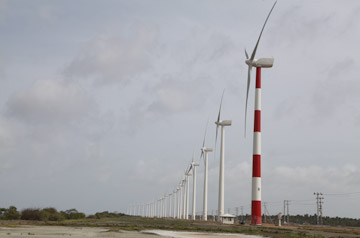A CEB tender released on 28 November called for RFPs
for the establishment of 60 MW wind power plants in the capacity range
of 1-10 MW on a build, own and operate basis.
This approach is seriously flawed! Small scale piecemeal wind power
development is far off optimal in terms of economic harnessing of an
abundant resource. Utility scale wind power should not be viewed as mini
hydro or a small power project. The benefit of ‘economics of scale’
should be recognised. A larger capacity wind project results in a
reduced cost of energy.
It is clear that the CEB technocrats lack understanding of the business
of developing utility scale wind power and, further; it appears that
that they do not view wind resources as a major asset for meeting the
future electricity demand.
The same sentiments apply in the case of harnessing utility scale solar
power. While much of the world follows a path of maximised harnessing of
renewable energy (RE) resources such as wind and solar, such thinking
is not prevalent within the power sector technocrats in Sri Lanka.
Meanwhile it is worth noting that Minister of Power and Energy Mahinda
Amaraweera recently stated that Sri Lankan would meet 70% of its power
requirement through “green” energy by year 2030 (News First TV on 16
December).
Global wind power
The global wind power market continues to grow at an exponential rate.
The wind power drive is led by countries such as China, the US, Germany,
and India. The need for clean, reliable and affordable power is the
most significant underlying factor for the wind power market growth.
The regulatory framework and policy structure supporting wind power in
various regions and countries has led to significant developments for
the industry and has seen the leading wind power nations adopt growth
trajectories.
https://www.power-technology.com/comment/global-wind-power-market-expected-to-approach-125bn-by-2030/
Why wind power in Sri Lanka?
The island has abundant wind resources and the technology for harnessing
this resource is mature, advanced and cost competitive with
conventional fossil fuelled power generation.
The benefits of wind power are as follows:
Energy security
Risk avoidance – fuel price, currency
Skilled employment opportunities at dispersed locations
Opportunities for private sector investment
Meeting climate change concerns/obligations
Provide ‘green’ credentials to exporters, corporate sector, tourist industry, etc.
Essential elements for wind development
With macro scale wind resource assessments already completed island
wide, the next steps to facilitate harnessing the resource would be to;
a) zone wind resource rich lands; b) conduct initial environmental
examinations (IEE) to block out sensitive areas, and; c) map parcels of
land for leasing to private sector developers on the basis of a
competitive tariff auction.
The land use impact of wind farms should be clearly understood. While a
wind farm spread on land is extensive, the ‘on ground’ impact is
minimal. For example, a 100 MW wind farm with multiple arrays of
turbines will have a foot print of less than 3% of the extent of land
covered. The land can be subject to ‘dual use’ such as agriculture,
animal husbandry, process industries, etc. With modern high capacity
wind turbines reaching tower heights over 100m, it is possible to build
wind farms amidst coconut plantations or forested lands where the wind
resources are promising.
Fossil fuel appetite
While the RE industry is growing worldwide, Sri Lanka power sector technocrats continue to prepare generation expansion plans that emphasise coal and LNG based plants with token allocation of wind and solar. Since a correlation exists between economic growth and electricity supply, past programs featured large capacity fossil fuel based plants to meet the demand of industry, commerce and the needs of the citizens.
However, today’s thinking views the harnessing of RE resources for electricity generation as an important element in the economic and technological development of the nation. Why export prosperity to a fossil fuel supplying foreign nation and be exposed to risks while indigenous resources are available? Additionally the carbon footprint is an important factor that effects an economy dependent on exports and tourism.
Sri Lanka is uniquely blessed with abundant wind and solar resources that can be harnessed to generate electricity that can be blended with the generation from existing hydro and fossil fuelled power plants. Use of modern technology helps to ensure stable operation of the integrated system.
It is time the national leadership paid heed to global trends and visions expressed in the ADB/UNDP study of 2017 and Stanford University ‘The Solutions Project’ study of 2018 where the options for attaining a 100% RE power system in Sri Lanka by year 2050 were explored. While the goal espoused in these studies may be viewed as idealistic, they are meant to influence power system planners about the promise of RE.
The writer hopes that the new national leadership will take a close look at global phenomenon where the electricity generation industry is undergoing a fundamental shift from centralised fossil fuel based power sources to increasingly decentralised RE based systems. It is time to spell out a clear vision and lay out a strategy that moves Sri Lanka towards a RE dominant power system in the coming decades.
Mayura Botejue
(The writer is a Renewable Energy Specialist, former Head of Projects – GE Wind Energy North America and pioneered wind project developments in Pakistan.)


